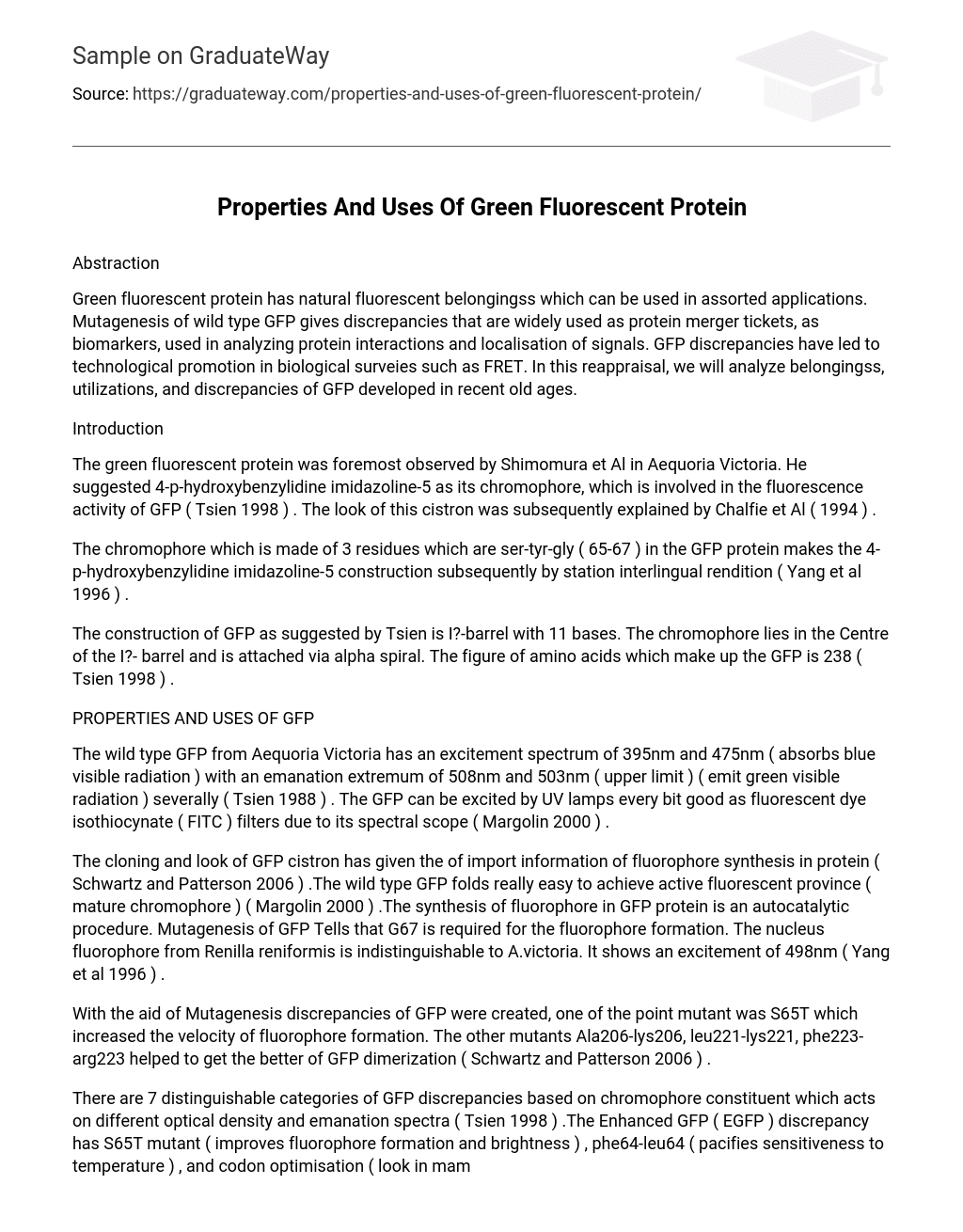Abstraction
Green fluorescent protein has natural fluorescent properties which can be used in various applications. Mutagenesis of wild type GFP gives variants that are widely used as protein fusion tags, biomarkers, for analyzing protein interactions and localization of signals. GFP variants have led to technological advancements in biological studies such as FRET. In this review, we will examine properties, uses, and variants of GFP developed in recent years.
Introduction
The green fluorescent protein was first observed by Shimomura et al. in Aequorea Victoria. He suggested 4-p-hydroxybenzylidine imidazoline-5 as its chromophore, which is involved in the fluorescence activity of GFP (Tsien, 1998). The expression of this gene was later explained by Chalfie et al. (1994).
The chromophore, which is made up of three residues ser-tyr-gly (65-67) in the GFP protein, forms the 4-p-hydroxybenzylidine imidazoline-5 structure after translation (Yang et al., 1996).
The structure of GFP, as suggested by Tsien, is an β-barrel with 11 strands. The chromophore lies in the center of the β-barrel and is attached via an alpha helix. The number of amino acids that make up GFP is 238 (Tsien, 1998).
PROPERTIES AND USES OF GFP
The wild-type GFP from Aequorea Victoria has an excitation spectrum of 395nm and 475nm (absorbs blue light) with an emission peak of 508nm and 503nm (maximum) (emits green light) respectively (Tsien, 1988). GFP can be excited by UV lamps as well as fluorescent dye isothiocyanate (FITC) filters due to its spectral range (Margolin, 2000).
The cloning and expression of the GFP gene have provided important information on fluorophore synthesis in proteins (Schwartz and Patterson, 2006). Wild-type GFP folds very easily to achieve an active fluorescent state (mature chromophore) (Margolin, 2000). The synthesis of the fluorophore in the GFP protein is an autocatalytic process. Mutagenesis of GFP shows that G67 is required for fluorophore formation. The core fluorophore from Renilla reniformis is identical to A. Victoria, and it shows an excitation of 498nm (Yang et al., 1996).
With the help of mutagenesis, variants of GFP were created. One of the point mutants was S65T, which increased the speed of fluorophore formation. The other mutants, Ala206-lys206, leu221-lys221, phe223-arg223, helped to overcome GFP dimerization (Schwartz and Patterson, 2006).
There are 7 distinct classes of GFP variants based on chromophore constituents which act on different absorbance and emission spectra (Tsien, 1998). The Enhanced GFP (EGFP) variant has an S65T mutation (improves fluorophore formation and brightness), phe64-leu64 (pacifies sensitivity to temperature), and codon optimization (expression in mammalian cells), which makes it a useful protein tag (Schwartz and Patterson, 2006).
There have been advancements in the development of cyan and yellow-shifted mutations (CFP and YFP) from A. Victorias, which are pH-sensitive and mature faster than the wild type (Chudakov et al., 2005). Cerulean is a bright CFP developed by Rizzo et al. to utilize it in FRET-based detectors for glucokinase activation (2004).
GFP mutations can be used as fluorescent markers for clip-independent cell procedures. When mutations of GFPs are immobilized in aerated aqueous polymer gels and are excited at 488 nm, they show perennial rhythms of fluorescent emanation (blinks several seconds). Hence, they are also used as molecular switches on optical storage elements (Dickson, 1997).
Elowitz et al. (1997) found that photoactivation of GFP takes place in the presence of low oxygen. Among several photoactivatable proteins, PA-GFP (thr203-his203) from A. Victoria was the first which has a 100-fold increase in green fluorescence at 517 nm. KFP1 is a recently developed discrepancy obtained from Anemonia sulcate which can be irradiated in reversible as well as irreversible ways upon green light irradiation (Chudakov, 2005).
The plasmid vectors which are used to show proteins in bacteria use GFP merger expression system. A number of proteins involved in the cell division process in E. coli have been fused with GFP and expressed by lac booster (Margolin, 2000).
GFP fused with Dictostelium myosin cells was used to analyze myosin activity. The expression of GFP myosin fused protein proved that myosin is involved in cytokinesis and the development of Dictostelium discoideum (Moores et al., 1995).
GFP is protected from photobleaching by its stiff shell. Certain mutations are created by random combinations and directed mutagenesis (Kasprzak, 2007). Major alterations in fluorescence can be obtained by technology of the phosphorylation sites under defined conditions.
FLIP (fluorescence loss in photobleaching) and FRAP (fluorescence recovery after photobleaching) are fluorescence imaging techniques that are used to analyze protein dynamics, which is performed by photobleaching (Baker et al., 2010). GFP along with these techniques is used to analyze gap junction channels in live cells.
FRET (fluorescence resonance energy transfer) is the most commonly used engineering technique to create biochemically sensitive GFP sensors. In this quantum mechanical phenomenon, the emission spectra of two nearby fluorophores overlap with the excitation spectrum of each other (one acts as a donor and the other as an acceptor).
It is also used to analyze the distance between protein residues and to monitor motor motions (actin or microtubules). The chromophores of GFP are labeled as donor and acceptor and are linked with motor proteins. There are three approaches, namely, single-pair molecule FRET (spFRET), luminescence resonance energy transfer (LRET), and transient FRET measurements (Kasprzak, 2007).
Miyawaki et al. (1997) developed indicators, which they called cameleons, for monitoring Ca+ signals in organelles and cytosol. The cameleons were created by using blue/cyan emitting GFP mutations, calmodulin, calmodulin-binding peptide, and blue/green emitting GFP. They used the FRET method.
Abad et al. (2004) developed a chimera of GFP that is used as a probe for analyzing changes in mitochondrial matrix pH.
In summary, there are various types of GFP used in different applications, which allow multicolor labeling of cells for detection. It has provided a new perspective in fluorescent imaging techniques such as FRET, FLIP, and FRAP. Monitoring promoter activity and localization of signals have become simpler with the use of GFPs.





